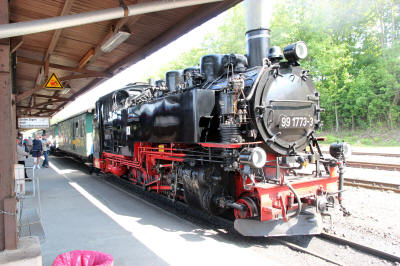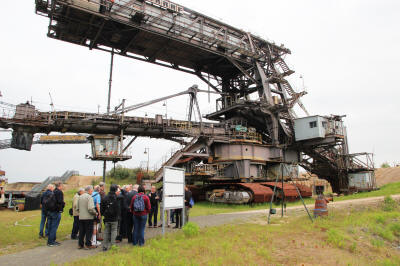|
AIA Spring Tour Saxony 14th - 20th May 2018 |
|
| Just a few images from our tour | |
|
|
Sächsisches Industriemuseum, Chemnitz The Industrial Museum of Saxony in Chemnitz is not just about machinery, but also about men and women. The museum is housed in a listed foundry building from around the turn of the 20th century. Inside faces stare down from the walls; historical, contemporary, famous and unknown. A complete “street” of textile machines spins, knits and weaves the history of the textile industry in Saxony and there are many exhibits covering the industries of Saxony - including a Trabant (left) adapted for a camping tour. |
|
|
Gasholders / Panometer In the years before natural gas was supplied via trunk lines (for example from the North Sea or Russia), gas (or town gas) was produced by gasworks usually located near to towns or cities. In steel making areas gas produced as a by-product of coke manufacture might also be supplied for industrial and domestic use. Whilst the supply of gas from the gasworks was more-or-less constant, demand for gas had peaks and troughs depending on the time of day and other factors. To ensure there was a supply of gas to meet demand it was necessary to store gas when demand was low and release it from store when demand was high. Hence the necessity for gasholders, or gasometers as they are often, wrongly, called. In Dresden two gasholders were built in 1878 and an additional “Main Gas Tank” (left) built between 1907 and 1908. The building is 67 metres high with a diameter of 60 metres. It consists of reinforced concrete unlike the two older gasholders which are of a solid brick wall. The Main Gas Tank was closed by a domed roof of steel girders topped by a lantern for ventilation. There are stair towers for reaching the interior corridors. In the past, inside a cylinder moved up and down according to the volume of stored gas. The Main Gas Tank, which is a listed building, no longer has a canopy. |
|
|
The Diesbar The Paddle Steamer Diesbar was built in 1884. She is 52.7m long and had her maiden voyage on 15th May that year under the name Pillnitz. So we had the pleasure of travelling aboard on her 134th birthday! The ship was renamed Diesbar in 1927 and is the only paddle steamer in the fleet still to be fired with coal. She is unique in that she is propelled by the world´s oldest operating marine steam engine, a two cylinder oscillating design built by John Penn & Sons in Greenwich. The engine was fitted in the PS Bohemia in 1841 then the PS Stadt Meissen in 1857 then in the Diesbar in the late 19th century. |
|
|
Ribbon weaving, Großröhrsdorf Großröhrsdorf is characterised by a tradition of ribbon weaving which reaches back to the 17th century and the village became well known throughout Germany and further afield as a result. The weaving trade was introduced by George Hans in 1680 and the first factories were founded as more weavers settled in the area. Over time more advanced weaving technology was introduced to those plants which resulted in the fabrication of webbings, wire and elastic bands as well as thread. The image shows an early loom being demonstrated |
|
|
Knappenrode Energiemuseum With the industrialisation in the second half of the 19th century the demand for brown coal increased steadily. This resulted in the opening of numerous mines between 1909 and 1915. First the open pit “Werminghoff” was exposed and started the building of the corresponding factory. Additionally, a worker´s village was established in the surrounding area. The company reached its highest annual production with 1,577,000 tons in the early 1960s. The row of machines (left) compress the dried powered brown coal into briquettes for industrial and domestic use. |
|
|
Göltzsch Valley Bridge The Göltzsch-Valley-Bridge, situated close to Mylau, was the prototype of valley bypassing bridges and is regarded as the largest brick bridge in the world today. It was designed by Professor Johann Andreas Schubert. The engineer Ferdinand Dost supervised the construction and up to 1,736 building labourers were employed at times. The structure is 574 metres long and 78 metres high. It consists of four levels with 81 arches altogether. Bricks served as the basic material, mainly because they could be produced very cheaply from a clay deposit nearby. |
|
|
The Schauweberei, Braunsdorf The weaving mill Tannenhauer looks back on a one-hundred-year-old history. At the beginning of the 19th century, a spinning mill was built in Braunsdorf in the valley of the river Zschopau. Martin Tannenhauer bought the property including the building in 1910. The building complex did not get damaged during World War II and from 1972 to 1978 the weaving mill operated as an independent nationally-owned enterprise. Image (left) of multi-coloured warp threads. |
|
|
Lime Works, Lengefeld The history of limestone mining in and around Lengefeld reaches back to the middle of the 16th century. First it was only quarried in open pits but underground mining was established in 1921. During WW2 artworks from the Dresdner Kunstsammlungen were put in storage here. The lime labourers resumed their regular work after the end of the war but two years later the company became publicly owned. Firstly the works produced quicklime, but changed over to the fabrication of terrazzo chippings in 1975. |
 |
Frohnauer Hammer In the first half of the 15th century a flour mill was constructed on the present site. Then in 1498 a mint was started in the same buildings. After numerous vacancies and several conversions including an oil mill, a copper and a silver hammer mill, the works were rebuilt in the years 1657 to 1660 as an iron processing plant. Finally, after a fire in 1692, the hammer mill was built in its present form. The energy supply was guaranteed by using the water power of the mountain stream “Sehma”. By the use of a leat and an overshot water wheel a capacity of 12 horsepower was achieved. |
 |
The Fichtelbergbahn The Fichtelbergbahn is a 750 mm (2 ft 5 1⁄2 in) narrow gauge railway that leads from the standard gauge line at Cranzahl to the ski resort of Oberwiesenthal in the Erzgebirge mountains which at 893 m (2,930 ft) is the highest town in Germany. It takes its name from the Fichtel Mountain near Oberwiesenthal. The line is 17.35 km (10.78 mi) long with a maximum incline of 33%. After the railway from Chemnitz to Chomutov was opened in 1872, plans were made to connect the former mining town of Oberwiesenthal to the Saxon Railway system. Construction started in 1896 with the railway opening in 1897. |
 |
Mining Technology Park The Leipzig Neuseenland owes its creation to the extraction, refining and use of lignite as a natural resource that went on for decades. The Park presents a complete conveying cycle of a surface mine in an authentic and comprehensible way on approx. 5.4 hectares on a terrain typical for surface mining. The exhibit does not only show the renaturation of the cultivated landscape, preparation of the tarmac and water table drawdown, movement of overburden, extraction of coal, but also the restructuring and recovery of a whole landscape. |
